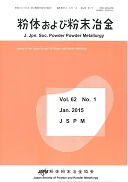All issues

Volume 62, Issue 1
January
Displaying 1-6 of 6 articles from this issue
- |<
- <
- 1
- >
- >|
Paper
Memorial Lecture of JSPM Award
-
Hisashi KOZUKA, Kazushige OHBAYASHI2015Volume 62Issue 1 Pages 3-9
Published: January 15, 2015
Released on J-STAGE: March 31, 2015
JOURNAL OPEN ACCESSThe replacement of metal electrodes by conductive oxides is useful in ceramic based products. LaCo0.5Ni0.5O3−δ demonstrates high stability and high electrical conductivity with a small temperature coefficient up to 1173 K in air. The electrical conductivity of 1.9 × 103 Scm−1 is due to the high carrier concentration of 2.2 × 1022 cm−3 and the small effective mass of 0.10 me. In addition, the temperature coefficient of the conductivity is smaller than that of standard metals, and little change in oxygen content occurs up to 1173 K in air. We believe that LaCo0.5Ni0.5O3−δ is suitable as a conductive material for electrode and electrical wiring at high temperatures in air.View full abstractDownload PDF (770K)
Paper
-
Kumiko TANAKA, Katsuhiro NISHIYAMA2015Volume 62Issue 1 Pages 10-17
Published: January 15, 2015
Released on J-STAGE: March 31, 2015
JOURNAL OPEN ACCESSThe effects of the addition of CeB6 on the densification and the mechanical properties of TiB2 – CeB6 composites (TCB) under the hot-pressing conditions were described. The TCB with cerium hexaboride content of 10 to 90 volume percent CeB6 were synthesized. The TCB is inexpensive and can be fabricated by a hotpressing sintering process. Addition of CeB6 and the formation of the solid-solution improved the mechanical properties of TCB. Especially, TiB2 – 30 % CeB6 composite had a bending strength of about 830 MPa and the micro-Vickers hardness of 30.5 GPa.View full abstractDownload PDF (1597K) -
Shunsuke MURAI, Makoto ARATANI, Koji FUJITA, Katsuhisa TANAKA2015Volume 62Issue 1 Pages 18-26
Published: January 15, 2015
Released on J-STAGE: March 31, 2015
JOURNAL OPEN ACCESSWe have examined the Faraday effect for iron oxide thin films deposited with silver nanoparticles. The iron oxide thin films were fabricated by using an epoxide-catalyzed sol-gel method assisted by water-soluble polymers. A single spin-coating process followed by a sequence of heat treatments allows the fabrication of polycrystalline γ–Fe2O3 thin layers with a porous morphology and a transparent appearance. The sample deposited with silver nanoparticles shows optical extinction ascribed to the localized surface plasmon resonances (LSPRs) ranging from 460 − 674 nm, depending on the size of nanoparticles. The magnitude of the Faraday rotation angle is enlarged around the wavelengths of LSPRs, showing a slight redshift of the wavelength of maximum enhancement with respect to the spectral position of the LSPRs. The numerical simulation explains that the shift is caused by the difference between far-field extinction and near-field enhancement of the electric field at the surface of the nanoparticle.View full abstractDownload PDF (1967K)
Rapid Communication
-
Kiyoshi MIZUUCHI, Kanryu INOUE, Yasuyuki AGARI, Masami SUGIOKA, Motohi ...2015Volume 62Issue 1 Pages 27-34
Published: January 15, 2015
Released on J-STAGE: March 31, 2015
JOURNAL OPEN ACCESSDiamond-particle-dispersed-copper (Cu) matrix composites were fabricated by spark plasma sintering (SPS) process from the mixture of diamond particles, pure–Cu and boron (B) powders. The microstructures and thermal conductivities of the composites fabricated were examined. These composites were all well consolidated at a temperature of 1173 K for 600 s by spark plasma sintering (SPS) process. No reaction at the interface between the diamond particle and the Cu matrix was observed by scanning electron microscopy and X-ray diffraction analysis for the composites fabricated under the sintering condition employed in the present study. The relative packing density of the diamond particle dispersed Cu matrix composites with B addition was 3.5~6.1 % higher than that without B addition. The thermal conductivity of the Cu/diamond composite drastically increased with B addition. The thermal conductivity of (Cu–B)–50 vol% diamond composites was 594~689 W/mK in a volume fraction range of B between 1.8 and 13.8 vol% in Cu matrix. Numerous transgranular fractures of diamond particles were observed on the bending fracture surface of diamond particle dispersed Cu matrix composites with B addition, indicating strong bonding between the diamond particle and the Cu matrix in the composite.View full abstractDownload PDF (1678K)
JSPM Announcements
-
2015Volume 62Issue 1 Pages Pref1_1-
Published: January 15, 2015
Released on J-STAGE: March 31, 2015
JOURNAL OPEN ACCESSDownload PDF (836K) -
2015Volume 62Issue 1 Pages Mtg1_2-Mtg1_6
Published: January 15, 2015
Released on J-STAGE: March 31, 2015
JOURNAL OPEN ACCESSDownload PDF (351K)
- |<
- <
- 1
- >
- >|